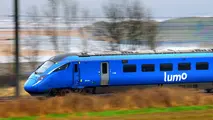Five Ways Innovation Can Unlock Rail Funding in the GBR Era
As the UK rail industry transitions into the Great British Railways (GBR) era, the funding landscape is shifting. Traditional mechanisms like Schedule 8 penalties are being rethought, and the business case for innovation is no longer as clear-cut as it once was.

A New Chapter for UK Rail?
As the UK rail industry transitions into the Great British Railways (GBR) era, the funding landscape is shifting. Traditional mechanisms like Schedule 8 penalties are being rethought, and the business case for innovation is no longer as clear-cut as it once was.
For the UK’s SMEs in the rail industry’s supply chain, this creates uncertainty. For the wider network, it creates urgency. HM Treasury, which subsidises the UK rail network and is generally risk averse when dealing with taxpayers’ money, will want to know that any changes to the funding landscape will deliver results.
Innovation is no longer a nice-to-have, it’s a necessity. It is the key to unlocking new revenue streams, improving operational performance, and positioning UK rail as a global leader.
But to foster innovation, we need to rethink how it’s funded, supported, and scaled. GBRX, the innovation arm of GBR, offers a blank canvas. The question is: will we use it wisely?
Here are five strategies for the UK rail industry to consider that could build a funding model which supports innovation and delivers long-term value.
1. Learn from What Went Before — and What’s Working Elsewhere
The CP6 to CP7 transition exposed a critical flaw: SME innovation frameworks weren’t carried forward. Promising technologies were left stranded, and investment momentum stalled. If CP8 repeats this pattern, we risk losing the very agility that SMEs bring to the sector.
Other countries offer valuable lessons. In Germany, for example, innovation is embedded into the business case through mechanisms that link performance directly to funding. Rail operators are incentivised to adopt new technologies because the financial logic is clear.
We should also look beyond rail. Aviation, logistics, and urban mobility sectors have embraced innovation through public-private partnerships, long-term funding commitments, and export strategies. UK rail must do the same, not just to survive, but to lead.
2. Create an Enabling Framework for Innovation
Innovation doesn’t happen in a vacuum. It needs structure, support, and a clear pathway to deployment. GBRX could be the hub that makes this happen, but only if it’s given the right remit.
Recent commentary highlights the need for:
- Defined innovation pathways.
- Simplified routes to market.
- Compliance measures that encourage early adoption.
GBRX must go beyond being a showcase for ideas. It should become the engine room for scalable innovation helping SMEs to navigate procurement, funding, and deployment. It should also act as a bridge between operational needs and technical solutions, ensuring that innovation is driven by real-world challenges and tested by real-world users, not abstract ambitions.
3. Get the Core Rail Service Working and Revenue Will Follow
Before we chase new revenue streams, we must fix the fundamentals. Reliability, availability, and customer confidence are the bedrock of any successful transport system. Without them, innovation is irrelevant.
Viper’s CableGuardian technology is a case in point. By significantly reducing delay minutes and identifying previously unknown failure modes, it has already delivered measurable operational improvements. But its wider value lies in enabling a more consistent, customer-focused service. The kind that drives repeat usage and builds trust.
If trains run on time, people and businesses will use them. If they don’t, they won’t. It’s that simple. Innovation must support this core objective. Only then can we build the case for broader investment and growth.
4. Explore Alternative Revenue Streams Beyond Passengers and Freight
Railways move things. Traditionally, that’s meant people and goods. But what else could they move?
At recent industry events, ideas have emerged around:
- Medical logistics: transporting test samples via passenger trains.
- Water management: using rail corridors to move floodwater or clean water.
- Energy distribution: leveraging overhead lines for EV charging or grid support.
- Data highways and connectivity: utilising the spare capacity of trackside fibre, known as dark fibre, for high speed internet and other data-intensive applications.
These aren’t just blue-sky concepts. They’re practical, scalable opportunities that could diversify rail’s revenue base. They also align with broader government goals around sustainability, resilience, and regional development.
Innovation in these areas could unlock new funding from departments beyond transport, including health, environment, and energy. But first, the rail industry must position itself as a multi-functional infrastructure asset, not just a transport provider.
5. Think Outside the Network and Export What Works
UK rail has a proud history of innovation. From interlocked signalling to digital twins, it has often led the way. But in recent years, that leadership has been diffused across different stakeholders. And recent major rail projects have not delivered results. GBRX offers a chance to reclaim it and demonstrate that there are still less risky winners in the rail technology arena worth backing by the Treasury with taxpayers’ money.
Once technologies are proven in the UK, they should be packaged for export. CableGuardian, for example, has clear applications in international markets where rail networks face similar reliability challenges. Exporting such solutions not only generates revenue, it also strengthens UK PLC’s global reputation and are more likely to lead to further Government investment.
To do this, we need:
- Clear innovation pathways.
- Support for SMEs to scale and internationalise.
- Business cases that factor in export potential from the outset.
Innovation isn’t just about fixing UK rail. It’s about creating solutions that others want to buy.
Conclusion: Innovation Is the Business Case
As GBR takes shape, the rail industry must rethink how it funds and fosters innovation. That means learning from the past, building enabling frameworks, fixing the basics, exploring new revenue streams, and thinking globally.
Innovation isn’t a cost — it’s the business case. And if GBRX gets it right, it could be the catalyst that transforms UK rail from a legacy system into a world-class network.



